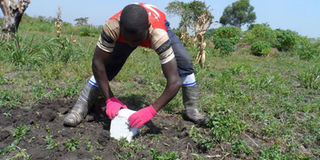Government embarks on boundary demarcation of wetlands

Markings. A surveyor from Ministry of Water and Environment puts a markstone at the boundary of Kiyanja wetland system in Kiboga District on January 31. PHOTO BY EDISON NDYANSIIMA
What you need to know:
The demarcation. The exercise involves retracing wetland boundaries and placing markstones.
Kiboga. The government has embarked on boundary demarcation of Kiyanja wetlands in a move to conserve the marshlands, which are disappearing due to encroachment.
Kiyanja is a trans-border wetland which covers six districts of Mubende, Kiboga, Nakaseke, Kasanda, Mityana and Luweero.
Mr Nicholas Magara, the coordinator of wetlands in central region, said the threat being imposed by human activities on the wetlands has forced them to demarcate its boundaries.
He said the demarcation exercise involves retracing wetland boundaries and placing markstones. This exercise has already started in the villages of Lwakitimba, Kakunju, Kalolora, Kateera, Kalagala, Kajjunju A, Kakujju B in the sub –counties of Dwaniro, Bukomero and Bukomero Town Council.
“A large chunk of the wetlands have been converted into an agricultural area and we have given the encroachers one month to harvest their crops, cut down all eucalyptus trees and vacate,” Mr Magara said during interview on Friday.
Records from the Kiboga District environment department indicate that 60 per cent of wetlands in the district have been degraded through human activities such as farming, house construction and sand mining.
Support
Mr Magara said after getting the backing of President Museveni, the Ministry of Water and Environment is determined to restore the depleted wetlands in Uganda.
“Our environmental patrol police unit has been empowered to enforce all laws governing the environment and we promise to leave no stone unturned,” he added.
Wetland degradation has devastated the potential of storing water and filtering pollutants. This has caused natural calamities such as floods, pollution of water bodies on Lake Wamala, Lake Kyoga and Lake Victoria hence declining fish stocks.
Mr James Kunobere, who led a team from National Environment Management Authority (Nema), said River Kafu banks have been depleted and some areas of the river have started drying up.
“We have already demarcated boundaries of River Kafu, but people have adamantly started reoccupying its banks. We have decided to sensitise residents and local leaders on the urgent need to restore the river,” he said.
River Kafu serves 10 districts including Kakumiro, Hoima, Kyankwanzi, Masindi, Kiryandongo, Mubende, Kasanda, Luweero, Nakaseke and Nakasongola.
Mr Edward Kisuuse, the secretary natural resources Bukomero Town Council, pledged support to the boundary demarcation exercise.
“We have already started experiencing adverse weather changes and it will be a disservice to the community if we just look on as people destroy the environment,” he said.
Last December, government evicted at least 300 encroachers from Musamya wetlands in Kayunga District.
The encroachers had since 2004 claimed sections of the wetlands, despite warnings from Nema officials in both Kayunga and Mukono districts.
Officials from the Ministry of Water and Environment are also in the process of restoring Namiiro wetlands in Entebbe Municipality where more than 5,000 encroachers have constructed houses.




